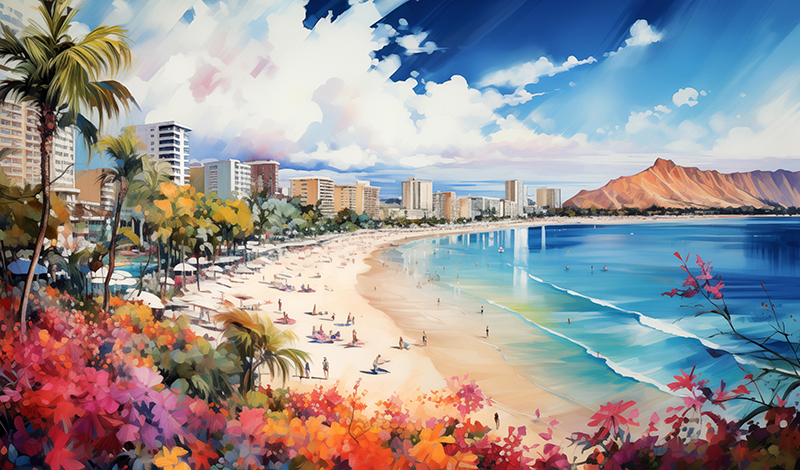Waikiki Beach is an iconic two-mile stretch of white sand and warm crystalline waters in Honolulu, framed by imposing hotels and varietal palm trees, including the Hawaiian, with its soft green leaves and pale, yellow flowers that waft the scent of honeysuckle.
On the morning of July 26, 1975, the beach became an outdoor arena for 30,000 spectators attending the SGI-USA’s Twelfth U.S. Nationwide General Meeting, billed as a pre-bicentennial event for the nation’s founding and attended by Ikeda Sensei.
In this issue, Living Buddhism chronicles Sensei’s 12th visit to the U.S. through the recollections of those present.
Ikeda Sensei arrived in Honolulu on July 22, 1975, to take part in the Blue Hawaii Convention, which would span three days, the centerpiece being a beach-side spectacular, performed from a man-made floating island.
Sensei’s first visit to Hawaii had taken place in October 1960, with some 30 members at a discussion meeting. Fifteen years later, the Blue Hawaii Convention brought together 20,000 SGI-USA members from throughout the U.S., along with representatives from several Central and South American countries and Japan, for an event that sought to “stir up a new, dynamic current for peace from Hawaii.”[1]
The convention was announced publicly in March 1974, with preparations already underway. To ensure its success, Sensei visited Hawaii in April 1974 to encourage the members and again in January 1975, on his way to Guam, to meet with representative SGI-USA leaders about the convention and Hawaii Governor George Ariyoshi to build understanding of the organization’s mission in advance of the event.
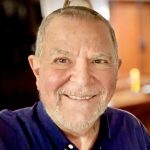
Gerry Hall (Los Angeles): In 1972, we had a big culture festival at the LA Sports Arena where we welcomed Sensei. A group of us became an unofficial committee to plan and execute the festival. I was asked to be the producer of the show, and I helped coordinate all of the moving parts. This core of people basically continued in that capacity for the Blue Hawaii Convention.
Thousands of people worked behind the scenes to make it a success. We weren’t onstage or getting recognition, but it was our pride and motivation to be a part of this movement for Sensei.
We worked hard to get official recognition from the American Revolution Bicentennial Administration (ARBA) to use their official logo and fought to receive permission and consensus from many of the Hawaiian officials to make this possible. It motivated all of us to feel that we were not just putting on a show in Hawaii, but this convention was important for the country’s recognition of our movement. We felt we could make the impossible possible because we were doing it together with our mentor to advance our movement for peace.
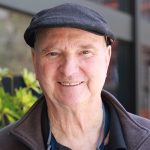
Gary Murie (Los Angeles): I worked with Gerry on the committee, and I was responsible for the stage—an island 600-feet deep, 100-feet wide and 70-feet tall—that would be floating in the middle of the ocean. It would be in the shape of a volcano with a large 35-millimeter motion picture screen mounted on top.
There were many moving parts: a parade down Kalakaua Avenue, a memorial monument at Pupukea, a Polynesian Village and a show at the Waikiki Shell, in addition to the two shows on the floating island.
After we got approval for the floating stage, we hired architects and engineers to build the structure so that it would be seaworthy and could be moved into place.
I was stationed in Hawaii for about five months, working full time in a warehouse we rented. For me, I was doing it with and for Sensei. And that’s what we communicated to the stage crew. We talked about it all the time. For us, it was no different than setting the stage for a shakubuku meeting. Sensei was there to give encouragement, and we were setting the stage.
Highlighting the Efforts of People Working Behind the Scenes
In volume 22 of The New Human Revolution, Sensei writes a detailed account of the event, in which he recalls his thinking at the time: “At this convention, I want to focus more on the support staff who are working hard behind the scenes than the individuals in the spotlight. I intend to encourage them with my entire being.”[2]
At the opening ceremony of the control center on July 23, Sensei greeted some of the support staff who were working hard in preparation for the week’s festivities. Concerned about the work and life circumstances of all the members participating, he spoke with some about their situations. Addressing one young man who quit an unappealing job to prepare for the convention, Sensei spoke about the true meaning of faith:
Of course, it’s important to chant and do your best in Soka Gakkai activities. But if you focus only on your Buddhist practice without making an honest effort at your workplace, you’re just escaping from reality. So long as you have that attitude, the results will be the same, no matter where you work. …
Regard your work as your practice of the Lotus Sutra and throw yourself into it wholeheartedly. When you strive to become the best person in your workplace and win the trust of your employer and fellow employees, while at the same time making an earnest effort to practice Buddhism, you’ll grow as a person.[3]
Sensei didn’t want the members to lapse into a mistaken view of faith. He sought to clarify that Nichiren Buddhism is a philosophy of human revolution, a practice that teaches how to challenge, polish and strengthen ourselves and become stronger and more humanistic in the process.
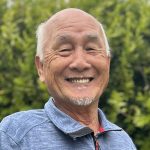
Eiji Miyamoto (Thousand Oaks, Calif.):I came to America in 1968 as an artist and was introduced to Buddhism by my wife, Keiko. In 1970, I joined the stage crew. I was a proud member, and I really enjoyed being a part of it. We were all so united!
Almost every night we painted backdrops at the Los Angeles warehouse. Then those huge paintings were shipped to Hawaii for the floating stage. I stayed in LA so that I could support from the warehouse. Even so, I felt great fortune in assisting even just a little bit. It was for Sensei. Every stage crew member had that spirit.
There was a room in the warehouse where we could chant together for a successful convention and Sensei’s safe trip.
I had so many breakthroughs as a part of this group. I see the tremendous benefit and fortune in my life and my family.
In Buddhism, one plus one is not two. With the Gohonzon, one plus one is 10,000, 1 million. It represents lots of benefits!
I have so much appreciation for Sensei and the many SGI members who supported me. I’m currently a vice district leader and we have many youth who come out. I tell them that if they center their life on the Gohonzon, they will win in everything. I also tell them to be in rhythm with the organization and do many activities. To be “free” and do whatever you please sounds good, but without practicing for self and others, you will never grow.
All of the stage crew members worked diligently, motivated by their wish for world peace and their enthusiasm to welcome Sensei. Of the stage crew members, Sensei said: “As they challenged their limits and worked together, sharing both sufferings and joys, they forged a strong camaraderie for kosen-rufu.”[4]
Encouraging the Members in Each Spare Moment
On July 23, Sensei met with a small group of representative members from Argentina and Hiroshima. He thanked them for traveling so far and spoke to them about the essence of faith, encouraging them by saying in part:
Life is a series of ups and downs, challenges and adversity. … At such times, we should chant with all our might. If we do so, in light of the teachings of Buddhism, we are certain to break through those difficulties. As we repeat this process throughout our lives and continue to strive for kosen-rufu, we’ll achieve our human revolution and build a life state of absolute happiness.[5]
The following day, Sensei and Mrs. Ikeda attended the opening ceremony for a garden built to commemorate the convention. He invited representative members from Brazil and Peru to a small group meeting afterward. There, he spoke about how hardships and challenges can become a springboard for winning in life. By facing difficulties head-on, we can tap our full strength and polish our lives.
In every moment, Sensei was tapping the limits of his ability to encourage the members.
The Convention Begins
July 25 served as the official opening of the three-day Blue Hawaii Convention.
That afternoon, Sensei visited the Polynesian Village the members built for the convention. Its purpose was to educate the participants about traditional Polynesian culture and traditions. The Hawaiian government had donated all of the bamboo they used to build the homes in the village.
Gary Murie: We had two warehouses, one in LA and another in Hawaii. At the Hawaii warehouse, we worked with the local Hawaii members to build the Polynesian village.
I remember being asked by our seniors in faith what we needed and I said, we need more people. One by one, stage crew members arrived in Hawaii. At peak, up to 1,000 members were there making preparations.
There were many things to do! But we chanted a lot—two hours in the morning and an hour at night. Seven days a week we worked all day. That’s how we made it happen.
That evening, lively music and bright lights filled the stage of the Waikiki Shell, an open-air auditorium, for the “Golden Hawaii Night Show.” It was an exciting exchange between East and West as it showcased the talents of members from the U.S. and Japan.
Several special guests were present, including the vice president of the Dominican Republic, the deputy speaker of the Hawaiian legislature and the mayor of Santa Monica, California.
The Twelfth U.S. Nationwide General Meeting
On the morning of July 26, 1975, some 30,000 spectators converged on Waikiki Beach for the SGI-USA’s Twelfth U.S. Nationwide General Meeting.
Skydivers in blue, yellow and red parachutes signaled the show’s start, drawing cheers from the spectators. A flare shot near the top of the floating island to help the skydiving team track the direction of the wind set fire to materials stored backstage. Spectators applauded as smoke rose from the cavity of the volcano, assuming it was part of the show.
Gerry Hall: I was in the control room on the sixth floor of a hotel overlooking the stage when I saw a fire. It was a nightmare. Sensei had just arrived in the underground parking lot of the hotel next door. On the radio, they were asking if it was OK for him to proceed to the stage via catamaran. I told them to hold off, and I kept communicating with the stage crew about the fire. They were fighting the fire with fire extinguishers until they were emptied. Finally, they threw the burning props into the sea. I then radioed an OK for Sensei to proceed to the island.
In The New Human Revolution, Sensei writes of the episode, recalling that he smelled something burning and asked if everything was safe when he stepped onstage. He wrote about the importance of staying vigilant and recommitting ourselves to safety when minor incidents take place.
We originally had planned to have the volcano erupt with fire with big Hollywood special effects in the nighttime show. But after that incident, I made the difficult decision to call it off. I felt the weight of canceling it because the media had been told that the volcanic eruption would be an incredible spectacle.
I knew it would be a disappointment, but I was determined not to allow another fire. I put safety first. Reading The New Human Revolution after the fact, the lesson is so clear.
The general meeting began with words from local officials, followed by Governor Ariyoshi and the vice president of the Dominican Republic.
When Sensei took the stage, his voice reverberated on the beach, as he voiced his commitment to realizing world peace.
Speaking of the Aloha spirit of the people of Hawaii, he described how aloha is used as both a greeting and farewell. It’s an expression of warmth, friendship and harmony that conveys mutual respect and peaceful coexistence. Sensei said that this spirit is similar to the teachings of compassion in Buddhism, saying:
If the courage and passion of the frontier spirit of which Americans are so proud can be successfully fused with the harmony and goodwill of the Aloha spirit through the cheerful practice of those of you who uphold the sanctity of life, there is no doubt that the United States will become a powerful driving force for achieving humanity’s earnest desire for peace.[6]
Sensei said that the mission of the practitioners of Nichiren Buddhism is to “transform themselves as individuals, overcome unbridled greed and egoism, and create a harmonious society in the United States and the world.”[7] The general meeting closed with a chorus singing the convention’s theme song, “Two Hundred Years From Now.”
Following the general meeting, the “International Show and Water Festival” took place, with a ballet performance set to the song “One World,” followed by cultural dances from around the world. With each act, the backdrop panels changed to reflect the local region. Then, 200 young women’s division members took to the stage and dove into the water for a synchronized swimming routine.
These young women, none with prior experience, had rehearsed for months. Every rehearsal was a battle, but on that day, having challenged their perceived limitations, the swimmers shone brightly. Each of them had valuable experiences in faith based on training their life through this activity.
For the finale, more than 400 performers gathered onstage holding flags from every nation. Sensei and Mrs. Ikeda applauded enthusiastically from their seats.
That evening, a commemorative reception was held with 300 representative overseas guests, followed at 8 p.m., by a big parade down Kalakaua Avenue, traveling across the tourist center of Waikiki, in celebration of the general meeting. The parade welcomed 50,000 spectators with many looking out from their hotel room windows. Some 4,000 from the U.S. and other countries performed in this exciting and colorful parade.
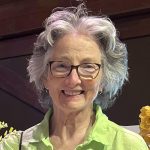
Peigi Duvall (Carmel, Calif.): I was responsible for the 30 to 40 young women’s division Fife and Drum Corps members from Northern California who performed in the parade. I began practicing Buddhism right after high school in 1967 in the hippy era, but many of the Fife and Drum Corps members were still very new to the practice.
Conventions could be quite frenetic, but the young women challenged themselves as best they could and experienced many great benefits from chanting Nam-myoho-renge-kyo. We were going to Hawaii, but we were not thinking much about sunbathing or surfing. With the “Aloha spirit” of promoting harmony and respect, we were strongly focused on accomplishing our human revolution and learning to transform any negativity through this activity.
Personally, for me, I was seriously considering my future—furthering my education, possibly marriage and a family—a completely new phase for me.
Over the years, I faced many challenges, but I’ve always sought Sensei’s guidance and Nichiren Daishonin’s writings. I determined to have the kind of practice that was a blue deeper than the blue of the indigo plant itself.[8]
Those experiences as a youth in the Fife and Drum Corps and supporting members built the foundation of my faith. It taught me how to use faith and practice to transform my karma. Now every day, I experience the tremendous benefits of this practice.
One of the things I value most are the friends, stateside and global, that I’ve made. Some of them, now almost 50 years later, are still my closest friends. When we get together, we laugh, cry and redetermine to always fight forward. Sensei shared his vision of a beautiful humanity when we were in our 20s together, and together, we’ve watched our lives grow.
That would be my advice to the youth: Make many friends in the youth division. They will become your greatest treasures.
The Convention Concludes
July 27 was the final day of the Blue Hawaii Convention. That evening, the U.S. Navy Pacific Fleet Band performed, followed by the “Spirit of ’76 Show,” a 30-scene musical, celebrating the history and spirit of the founding of the United States in 1776. The singers and dancers portrayed scenes from American history and conveyed the struggles, idealism, courage and pioneering spirit of those who helped build the U.S.
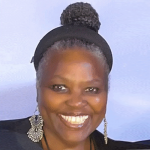
Babe “Debi” Evans (Los Angeles): I joined the SGI in January 1974, so I was practicing for a little over a year. The youth in my chapter were so vigorous and one of the first large activities I ever attended was Sensei’s lecture at UCLA. At that lecture, the whole room was full, so I was standing on the stairs. Sensei came up those same stairs, and I shook his hand. I was about a three-month member then, and I will never forget his warmth.
Those same friends encouraged me to go to the Hawaii convention. Every Sunday we met at the Santa Monica Beach to rehearse. When I look back, those friendships, lifelong friendships that were formed through doing activities together, were the most important. The camaraderie was built through practicing and doing activities together.
Years later when my son passed away, it was my Soka family and friends who got me through it.
When I was 23, I was doing activities because it was fun, and I was following the crowd. But now I do them because I know I’m making a difference in the world.
I’m determined that my husband, Art, and I will be fighting for kosen-rufu together in 2030 in the best mind, body and spirit, supporting the SGI and the youth division. I will be 80 then, but I want the youth to look at me and say, “She’s been through a lot, but she still is young and beautiful!”
The elaborate costumes worn by the performers were all sewn by volunteers across the U.S. at nine workshops. Although many were facing personal problems, they proudly worked together, encouraging one another in the process. In three months, they made 2,000 costumes.
As a finale, the members sang “Forever Sensei” together, expressing their commitment to advance kosen-rufu with their mentor. Thunderous applause could be heard amid the roar of fireworks illuminating the night skies.
The historic convention had come to an end. While Sensei called the convention a triumph of unity,[9] he spoke strictly to the general director afterward regarding the place and timing of conventions in the kosen-rufu movement.
Clearly, our priorities are reversed if by constantly holding spectacular conventions we only end up exhausting the members’ time, energy and financial resources, making them too worn out to introduce others to Buddhism, study the Buddhist teachings and participate in discussion meetings. You need to rethink the way that you hold conventions, which are just growing bigger and more extravagant year after year and causing an increasing drain on members. The most essential thing is our day-to-day Soka Gakkai activities, which require earnest, painstaking efforts behind the scenes. And it is in ensuring that each member experiences real joy through their practice, gains trust in their community and workplace, and wins in life. That’s the real purpose of our movement.[10]
Sensei continued to encourage the members after the event, visiting the Hawaii Community Center on July 29 to express his gratitude to those who had worked so hard behind the scenes.
After they did gongyo together, Sensei joined the support staff at a garden party in the courtyard of the Hawaii center. Several women were grilling at barbecue stations. When Sensei arrived, he immediately went to them, saying: “You’re guests here today. I’d like to serve you, to show my appreciation.”[11] He began grilling and serving the members. After some time, members performed Hawaiian dances on a stage set up for the occasion.
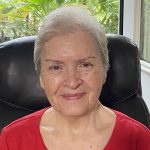
Eva Torres (Honolulu): My brother was introduced to Buddhism in Waikiki by women who were passing out the World Tribune. He introduced our whole family including me and my husband, Tiger. We received the Gohonzon in 1972.
We were told that there would be a big convention happening in Hawaii and they were looking for hula dancers. There were 30 dancers, and many of us were newer members.
We performed at the garden party after the convention. I didn’t know much about Sensei, but I remember that he was so eager to meet us, the performers. He had a medium-sized watermelon and he said to a few of us, “This is for you.” It felt like meeting someone that I had known for a long time. I will never forget that first encounter with him. I felt his warmth, friendliness and compassion.
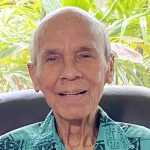
Segundo “Tiger” Torres (Honolulu): In the days leading up to the convention, the planes were coming in every 10 minutes or so with members from all over the United States. People loaded the streets—they were all SGI members. That was so beautiful to see thousands of members come to the Island. I felt so happy.
Eva Torres: I still have local newspaper clippings from that time that had explanations of our organization and how we stood for world peace. It was such a positive introduction to Buddhism and, following that festival, many local people of all races joined the SGI in Hawaii.
Sensei talked about the “Aloha spirit.” Both Tiger and I are part Hawaiian. The Aloha spirit is the welcoming spirit. It’s a spirit of embracing people no matter who they are. It is the spirit of having an open heart.
When I think about our movement, that spirit is so important because world peace will only happen through one-to-one relationships.
The Blue Hawaii Convention cemented our practice because we weren’t just talking about world peace, we were experiencing what it could look like.
Tiger and I are now both in our mid-80s and at this stage of our lives, we have nothing but appreciation. To the youth: Use this practice daily, build lives of good fortune and have no fear. Continue practicing and challenging everything with Nam-myoho-renge-kyo and protect the organization.
After the convention, the SGI-USA donated 2,000 Japanese language books to the Hawaii State Library, made financial contributions to the children’s hospital and retirement home and gifted the Polynesian Village to the Honolulu Zoo. These gifts were an expression of the organization’s appreciation for the support and cooperation of the city and county of Honolulu and the state of Hawaii.
For the members present, the Blue Hawaii Convention was a turning point for their lives, cementing what kosen-rufu could look like through working together in the spirit of aloha, united in vision and action with their mentor to advance world peace.
From the July 2024 Living Buddhism
References
- The New Human Revolution, vol. 22, p. 94. ↩︎
- Ibid., pp. 98–99. ↩︎
- Ibid., pp. 101–102. ↩︎
- Ibid., p. 118. ↩︎
- Ibid., p. 124. ↩︎
- Ibid., p. 158. ↩︎
- Ibid., p. 160. ↩︎
- See “Hell is the Land of Tranquil Light,” The Writings of Nichiren Daishonin, vol. 1, p. 457. ↩︎
- Ibid., p. 178. ↩︎
- Ibid., pp. 179–80. ↩︎
- Ibid., p. 182. ↩︎
You are reading {{ meterCount }} of {{ meterMax }} free premium articles

